Sometimes I need an excuse to get some exercise, and taking a long walk can be more interesting if I bring my camera along. Here are some pictures I took in downtown Saint Louis on October 27th. I hope you enjoy them.
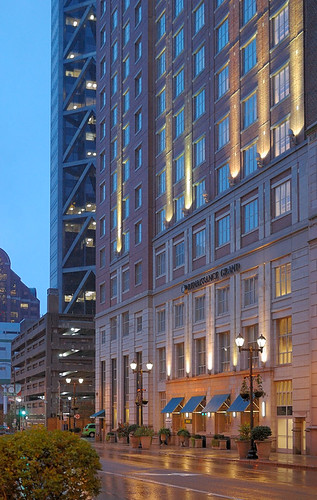
I walked around 8th and 10th Streets, between Washington Avenue and Market Street, a small part of downtown, but this includes the Convention Center and the Old Post Office. The photos presented here are in the order that I took them.
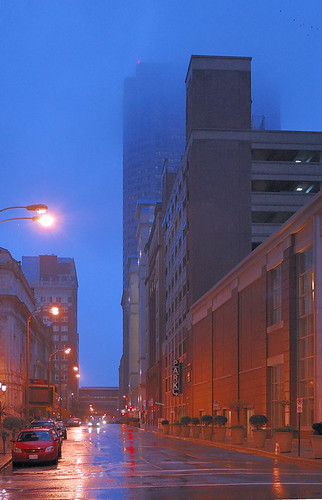
This is my favorite photo of the batch. There was a bit of fog, as you can see. City lighting is often photographically poor, and the harsh shadows during a sunny day often make it difficult to find a good camera angle to photograph tall buildings: but dusk is a delightful time of day to take pictures.
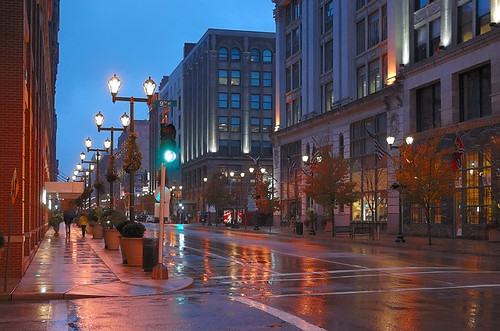
A look down Washington Avenue, towards the west. The building on the right, the old Lammert Building, houses the offices of the American Institute of Architects, who have a fine architectural bookstore on the ground floor.
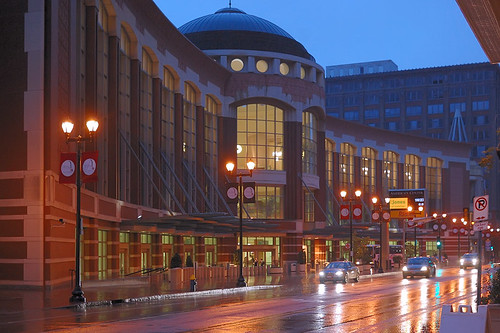
The convention center, which is connected to the football stadium.
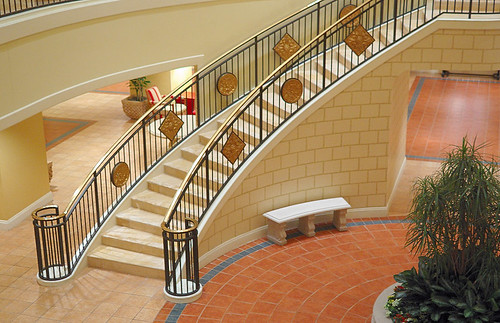
Escaping from the rain for a little while, I went inside. This is at the Renaissance Grand Hotel.
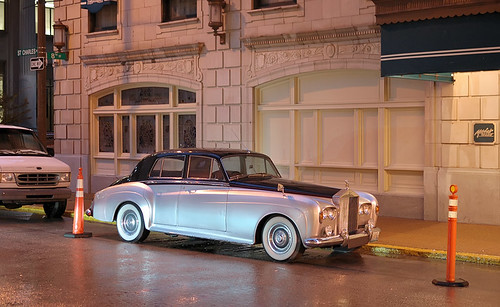
A Rolls-Royce. This kind of automobile is a rare sight in Saint Louis. This scarcity, I think, is not due to a lack of wealthy Anglophiles, but rather because of a certain Midwestern practicality.
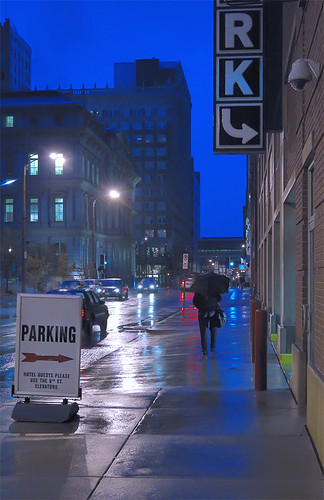
A woman with an umbrella walks down 9th Street.
These photos were basically taken without much planning or technical care. Especially as the evening got darker, these pictures have more problems with digital noise, poor focus, and blur due to slow shutter speeds. Also, highlights are overexposed, and the shadows lack much detail. So basically I took these partly as a technical challenge: what could I successfully photograph in the dark without a tripod?
For specific technical details, you can click on any photo, and then click “More properties”. While you are in Flickr, you can also get larger sizes and a map showing where I took each picture.
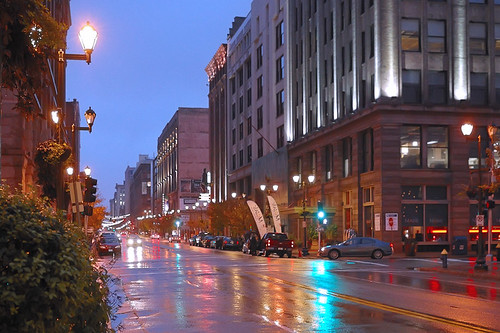
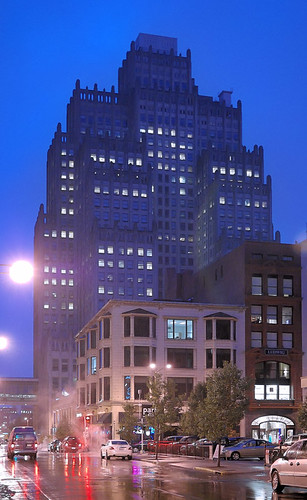
The old Southwestern Bell building, completed in 1926, is by the firm Mauran, Russell & Crowell. This building was the first in the city to incorporate setbacks; this innovation, originally developed in New York City, prevented tall buildings from blocking too much of the sky. The firm was responsible for many other monumental buildings in Saint Louis, including the Federal Reserve Bank, Soldiers Memorial, the Statler Hotel (now Renaissance Grand, seen above), and others.
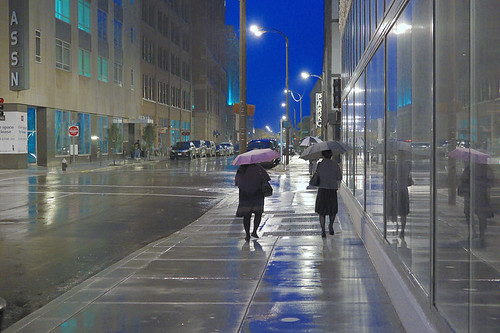
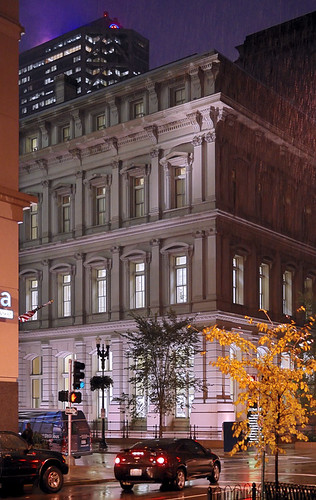
The Old Post Office.
I like that you can actually see that it is raining in this photo; some streaks can be seen at the upper right corner. I kept my camera dry that night by keeping it under my jacket, and by taking photos while standing under overhangs. Fortunately, I was wearing some wool clothing that were warm even when damp.
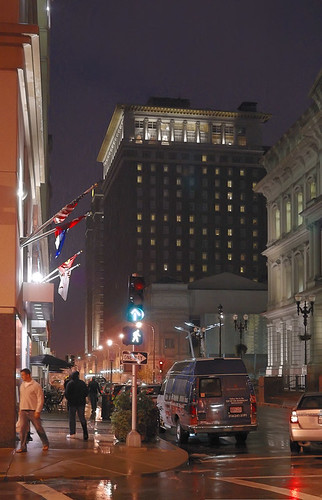
These photos are maybe a bit more human interest than my normal subjects. There is actually a whole genre of picture taking, called urban street photography, which specializes in candid photos of people going about their ordinary business.
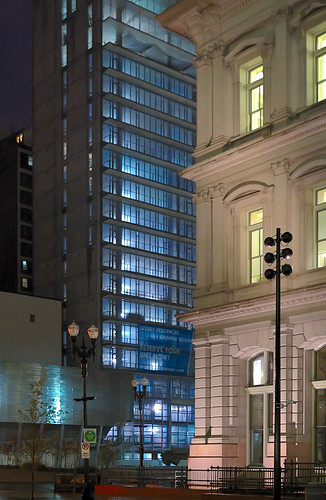
A new tall building is going up behind the Old Post Office. Will it be completed any time soon in this poor economy?

Tall buildings, or at least their upper stories, were once relegated to the poor until the invention of safe elevators. Ancient Rome was filled with insulae, highrise apartment buildings, whose upper stories were very undesirable places to live.
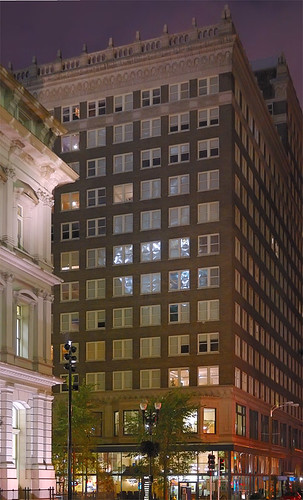
I took these photos with my Nikon D40, which is inexpensive and has good low-light capability; however, the lens that comes with the D40 kit is not fast enough to work at night without a tripod. For these photos, I used a cheap but good 35 millimeter focal length lens; it has an aperture of f/1.8, which brings in between four and nine times the amount of light as does the kit lens. Prime lenses — those with a fixed focal length — are typically faster, lighter, higher quality, and much cheaper than their zoomable equivalents. Generally speaking, most all current cameras with interchangeable lenses have sufficient low-light capability. Compact camera models usually have too much noise to produce acceptable hand-held images at night. Many old interchangeable-lens film cameras are also excellent for this purpose.
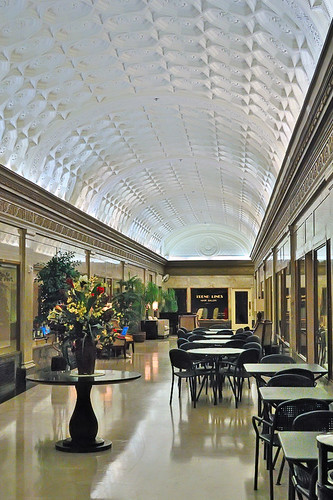
Lobby of the Paul Brown building, seen through a window.

Further down Washington Avenue; this was once called the Garment District, a major center of clothing manufacture in the United States. After the factories closed in the 1960s, this area went into decline, and became quite seedy. It has been largely redeveloped in the past ten years.
But this neighborhood is generally speaking only suitable for those who are young, hip, and childless. Catholics have long formed the core of the population of Saint Louis, but Catholic schools here are still closing with alarming frequency and few are within a reasonable distance from downtown, while the city's public schools have a terrible reputation.
The City Fathers, understandably, want to keep their elective offices, patronage jobs, and contracts, but this means only attracting voters who are happy with the political status quo. Saint Louis experienced severe population decline since 1950; in the decades since then, the city greatly depended on the taxes paid by those who worked in or visited the city but lived elsewhere. But with economic development in outlying areas, this proved unsustainable, with many local employers moving operations to lower-tax areas nearby. This led to the widespread development of residential entertainment districts in the city like this, with new loft apartments and many restaurants and nightclubs. But club kids are not very likely to have children, and this neglect of the schools may make this area even worse for families.
Policemen on 10th street.

The old Southwestern Bell building, completed in 1926, is by the firm Mauran, Russell & Crowell. This building was the first in the city to incorporate setbacks; this innovation, originally developed in New York City, prevented tall buildings from blocking too much of the sky. The firm was responsible for many other monumental buildings in Saint Louis, including the Federal Reserve Bank, Soldiers Memorial, the Statler Hotel (now Renaissance Grand, seen above), and others.


The Old Post Office.
I like that you can actually see that it is raining in this photo; some streaks can be seen at the upper right corner. I kept my camera dry that night by keeping it under my jacket, and by taking photos while standing under overhangs. Fortunately, I was wearing some wool clothing that were warm even when damp.

These photos are maybe a bit more human interest than my normal subjects. There is actually a whole genre of picture taking, called urban street photography, which specializes in candid photos of people going about their ordinary business.

A new tall building is going up behind the Old Post Office. Will it be completed any time soon in this poor economy?

Tall buildings, or at least their upper stories, were once relegated to the poor until the invention of safe elevators. Ancient Rome was filled with insulae, highrise apartment buildings, whose upper stories were very undesirable places to live.
Americans, generally speaking, are excessively optimistic, short-sighted, and have a terrible grasp of history, and the skyscraper is a prime symbol of these characteristics. Forgetting the moral sense of the story of the Tower of Babel, our tall buildings seem to be the result of pride in our own progress: the heresy of Pelagianism is rampant in our culture. While tall buildings afford great views, they are absolutely terrifying for occupants if anything goes wrong: and history tells us that things often go very wrong.
But I am all for tall spires and monuments, things that make you look up heavenward from ground level. Looking down from a tall building makes everyone below look like ants, which in the long run may be psychologically unhealthy, since you may think that they deserve to be treated no better than ants.
However, the moral and artistic error opposite from these tall buildings is the trend of large single-story generic pre-fabricated steel buildings. While tall buildings usually are showcases of architectural talent, these big box buildings are representatives of the lowest form of architecture. Tall buildings attempt to house too many people per acre, while the others do the opposite. I think the optimal size of buildings is two or three stories, with a basement, and with the most important public areas on the ground level: this is more on a human scale, and allows easy walking to all parts of the building for most people. These more human-sized buildings are also more amenable to traditional decorative and architectural styles.
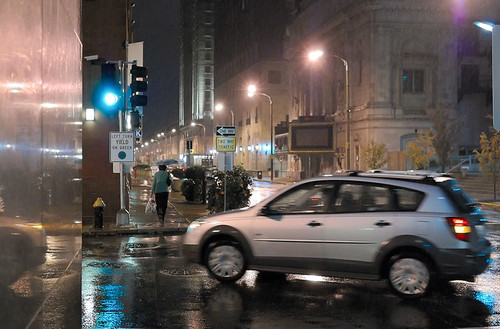

You don't need an exceptionally high-quality or expensive camera to take good pictures, especially if you use care in setting up the shot, know the characteristics and limits of your camera, and are able to do suitable image corrections on the computer afterwards.
However, you need to be able to get a shot in the first place, and in the dark, without supplemental lighting or a tripod, you need to have a shutter speed fast enough to actually get a picture without excessive blurring. And in this case, what camera and lens you use really does matter a lot.

I took these photos with my Nikon D40, which is inexpensive and has good low-light capability; however, the lens that comes with the D40 kit is not fast enough to work at night without a tripod. For these photos, I used a cheap but good 35 millimeter focal length lens; it has an aperture of f/1.8, which brings in between four and nine times the amount of light as does the kit lens. Prime lenses — those with a fixed focal length — are typically faster, lighter, higher quality, and much cheaper than their zoomable equivalents. Generally speaking, most all current cameras with interchangeable lenses have sufficient low-light capability. Compact camera models usually have too much noise to produce acceptable hand-held images at night. Many old interchangeable-lens film cameras are also excellent for this purpose.

Lobby of the Paul Brown building, seen through a window.

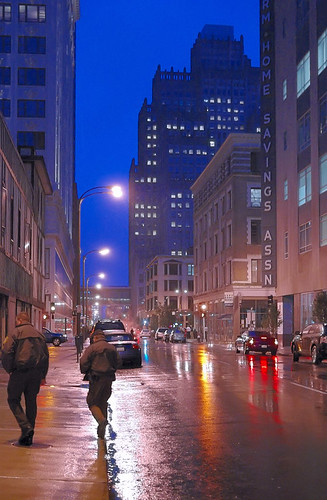
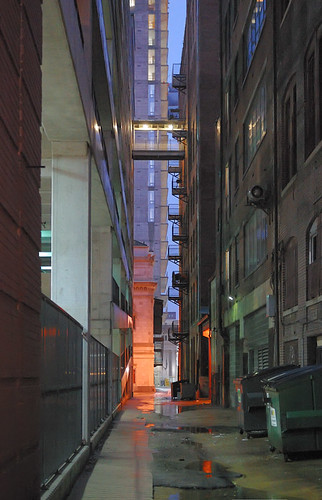
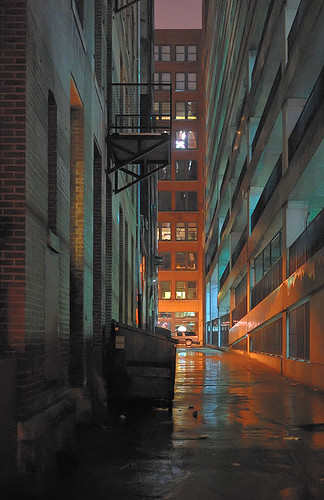
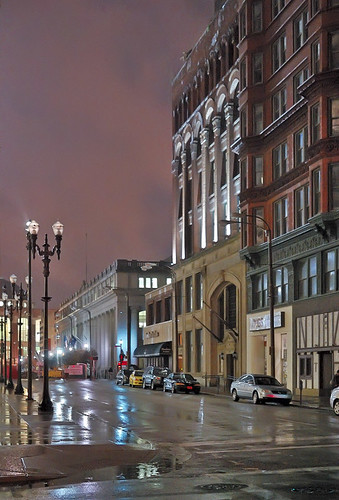


more great photos. You probably have grown weary of my posts on the subject but I have to come to your site daily to get of "breath" of St. Louis. The Rolls brought back a childhood memory.....in the very early 1960's in Chillicothe MO. there was man named Ed Walters who owned 2 Rolls Royce's and he even had radio phones in them. He also owned a home on the Lake of the Ozarks and had a ChrisCraft Cabin Cruiser, I have a photo of myself at the wheel of what seemed like a yacht to me at the time...
ReplyDelete:)
ReplyDeleteYou should do city hall and Kiel next.
I've visited Sullivans Union Trust many times but could never get good photos. Wouldlove to see you tackle this subject for your next outing.
ReplyDelete